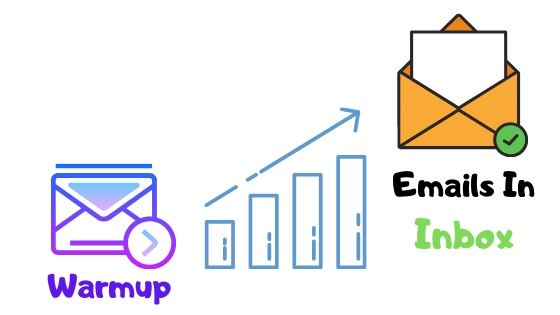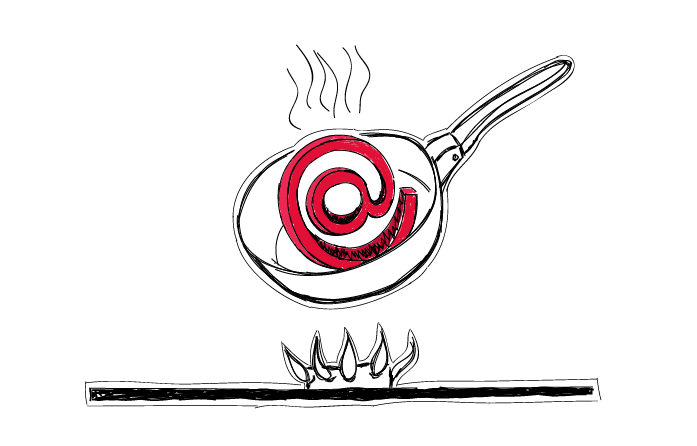Is your email address for outreach initiatives brand new? Learn how to email warmup manually before sending cold emails to improve your email reputation. Read this article to know how to warm up your email manually.
[toc]
Before sending cold emails, how do you warm up an email account?
Contents
Email deliverability is a significant problem when sending a cold email campaign (sequence).
According to a SuperOffice survey, more than 20% of emails never make it to the inbox. At Alore, we've seen new email accounts used for cold email campaigns get blocked as soon as the campaign starts.
The issue is that the new email accounts haven't had time to warm up.

With Google's spam upgrade, reaching the inbox is more complex, as most emails are now designated spam.
It is critical to warm up your new email account before beginning a cold email marketing campaign(sequence).
We'll show you how to warm up an email account before sending cold emails so that they get in the inbox instead of the spam folder.
Check Alore
What does it mean to "warm-up" your email?
The email warmup is a technique for establishing a new email account's reputation and increasing its email sending limit.
Sending emails from a new email account, beginning with a modest number and progressively increasing the number of emails each day, is part of the warming process.
The email service provider assigns daily sending restrictions when a user establishes a new email account. A new account cannot use it.
Warming up your email is necessary to build your reputation and increase your delivery rate. When designing a significant volume cold email campaign(sequence) with a new account, making sure emails get into inboxes is critical.
The initial step in a cold email campaign (sequence) is to get into the recipient's mailbox. Once you've arrived, having a solid interaction will help you create a stronger bond.
It will evade the spam filter, be delivered to the inbox, and have a greater open rate if the email is sufficiently warmed before sending cold emails.
So, without further ado, let's dig in and learn how to warm up an email account before sending cold emails that cause your account to freeze.
How should an email account be warmed up before sending a cold email?
Step 1: Authenticate your account
Step 2: Send individual emails.
Step 3: Keep Conversation Threads Going
Step 4: Sign up for newsletters
Step 5: Leave a reasonable amount of time between two consecutive emails.
Step 6: Set up a Personalized Test Campaign
Step 7: Best Bonus Practices
1. Authenticate your account
The first step in creating a new email account is account authentication. Authentication protects your account from spam filters and ensures that your emails get in the inbox.
Four types of email authentication are required:
SPF
Sender Policy Framework is an authentication method that involves creating a record in your DNS (Domain Name System) that specifies all of the servers permitted to send emails on behalf of a domain. When the recipient's ESP detects SPF Authentication on the sender's side, it gives the sender's domain a clean bill of health.

DKIM
DKIM (Domain Keys Identified Mail) is an authentication mechanism that adds a digital signature to your domain, preventing email spoofing and ensuring that your message reaches the intended recipient.
DMARC
Domain-based Message Authentication, Reporting, and Conformance are used in conjunction with SPF and DKIM records to ensure that the email is not affiliated with any deceptive operations.
Personalized Domain
By using a custom domain in your emails, you may increase the authenticity of your links and documents. As a result, the sender and his ESP may be confident that the links and documents are genuine.
Check Alore
2. Send personalized emails
Sending manual emails to friends and coworkers to start a dialogue is the first step in email warming.
You should first send 10-20 separate emails from the new email address. Ensure that the early emails have a constant level of interaction, as this will increase the volume.
During this manual procedure, ensure you're sending emails to different email providers, including Gmail, Yahoo, Outlook, iCloud, Godaddy, Zoho, Aol, Exchange, and Yandex. This will assist you in establishing a positive reputation with all of the major email service providers' spam filters.
PS: In the manual method, write a personalized subject line to receive a better response.

3. Keep dialogue threads going
Email accounts aren't simply for sending messages; you should also expect a response.
Creating interaction in your warm up emails is critical for optimum deliverability. As a result, start the dialogue by sending emails from your old accounts and responding to them from the new one.
Because this is an 8-12 week procedure, having regular interactions is essential. So, if at all feasible, include your new email address on your website for incoming inquiries and respond quickly to improve your conversation rate.
This straightforward procedure ensures the email service provider that your email operations are genuine. The continuing email dialogue progressively increases your email sending quota and qualifies your account to send bulk emails.
4. Register for newsletters
Several magazines send out weekly newsletters if you work in sales, marketing, recruiting, or other fields.
Go out and sign up for at least 10-15 newsletters. Each newsletter requires confirmation, so return to your mailbox and confirm each subscription.
5. Leave a reasonable amount of time between two consecutive emails
Each email service provider has its algorithms for determining how emails are sent and received.
So, to prove to those algorithms that you are not a robot, don't send too many emails at once. Sending a large number of emails regularly may harm your domain's reputation.

While warming up your new account, the most straightforward approach to avoid it is to have a significant time delay between two emails.
Sending too many emails at once might activate spam filters, resulting in your account being temporarily or permanently blocked.
Check Outreachbin
6. Create a customized test campaign
Your account will be prepared for automatic email campaigns (sequence) using Saleshandy after completing 12 weeks of manual warming.
However, it is advisable to begin modestly and uncomplicatedly. Start the initial campaign (sequence) with a modest list of 20-30 reliable recipients, including friends and colleagues, to ensure a response.
When your primary aim is to warm up your email account, you must get your receivers to open and reply to your email. Personalizing your email will solve your problem.
Create a customized email with Saleshandy and sound human. Create a customized subject line to get the most excellent open rate. Increasing the number of responses requires a tailored message.
Avoid spammy material
When you include spam content in your emails, your account becomes more exposed to spam filters. Use phrases like FREE, GRAB, 50% off, etc., in your emails to avoid attracting spam filters' notice.

Avoid sending anything that might harm your sender's reputation. Keep the material clear, straightforward, and restricted in quantity.
Include an unsubscribe link
Even if you're sending a test campaign(sequence) to a tiny list, including an unsubscribe link in your email is recommended.
While warming up your email account, you should eliminate any chance of the receiver spamming your messages. Even one spam report against a new version might severely impact your reputation.
Your receivers may select whether or not they wish to receive your emails by including an unsubscribe link in your emails. This feature makes your receivers delighted while keeping your emails out of SPAM filters.
Check mailchimp
7. Bonus best practices
Warming up an email account before sending cold emails with the recommended techniques listed above can help you activate your account's extensive list of cold email campaigns.
We've included some additional bonus ideas below to help you preserve your sender reputation and email deliverability.
Write as though you're a genuine person.
In your email text, use only a few links.
Choose your email service provider intelligently based on your requirements.
Use only a few media items, such as photographs, movies, and GIFs.
During email warmups, avoid automation.
When will you be able to turn off your email account?
Maintaining your email warmup exercise is beneficial and recommended.
This will negatively influence your email campaign(sequence) and positively impact you.
It will always keep a healthy balance of email activity to ensure that your email deliverability remains unaffected. Additionally, it signals your email service provider that you are not spamming the subscriber but rather a legitimate sender.
Conclusion
The entire system is designed to keep spammy content at bay. Following recommended practices can assist algorithms in recognizing you as a natural person rather than a spammer. Keep the following points in mind:
Warming up your email is critical since it has a significant impact on your sending reputation and deliverability. When looking for email warm-up software, make sure it uses real accounts from real people, has a trustworthy algorithm, and uses safe sending techniques.
If you're going to undertake manual IP warming, look over the list in this post to fine-tune your timetable and email content.
Finally, keep in mind that it is simpler to establish a favourable reputation as a sender.





.webp)


